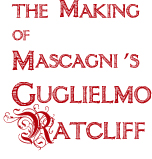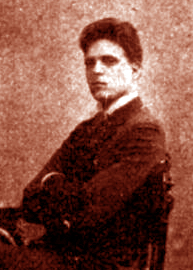 |
<< Previous
3. Mascagni and the Writing of Guglielmo Ratcliff
 t is a common misconception with the opera-going public that Mascagni composed Cavalleria Rusticana practically as a first work and never succeeded in producing another opera of any consequence. While the second of these assumptions will not be explored in the present article (the accompanying recording [i.e: the 1963 disc recording] serves, in this writer's view, as ample refutation), the first statement is worth examining in some detail. Before he undertook the composition of Cavalleria Rusticana, Mascagni had written two symphonies (C minor, F major), three masses (including a Requiem), four large choral works with orchestra, and in addition, numerous songs, small church pieces and various chamber works. Most importantly, he had already two operas to his credit, both unperformed: Pinotta and Guglielmo Ratcliff. The purpose of the present section will be to trace in detail, and largely in Mascagni's own words, the genesis of these two works. t is a common misconception with the opera-going public that Mascagni composed Cavalleria Rusticana practically as a first work and never succeeded in producing another opera of any consequence. While the second of these assumptions will not be explored in the present article (the accompanying recording [i.e: the 1963 disc recording] serves, in this writer's view, as ample refutation), the first statement is worth examining in some detail. Before he undertook the composition of Cavalleria Rusticana, Mascagni had written two symphonies (C minor, F major), three masses (including a Requiem), four large choral works with orchestra, and in addition, numerous songs, small church pieces and various chamber works. Most importantly, he had already two operas to his credit, both unperformed: Pinotta and Guglielmo Ratcliff. The purpose of the present section will be to trace in detail, and largely in Mascagni's own words, the genesis of these two works.

Pietro Mascagni at 26
One of the previously mentioned choral works was a cantata for soli, chorus and orchestra, In Filanda ("In the Silk-spinnery"), composed and first performed (1881) in the composer's birthplace, Livorno. Two years later, while at the Conservatory in Milan, Mascagni elaborated the cantata, changed the names of the characters and transformed it into his first opera, the "scenic idyll," Pinotta. In a letter to his librettist Targiono-Tozzetti, dated April 15, 1932, Mascagni described his revision of it:
"From In Filanda I saved four pieces from the first act and a small portion of the prelude. All the rest was suppressed when I recomposed the cantata and gave it the name Pinotta." It was to have been submitted in a contest among the Conservatory students but was not received in time, so the composer sent it to the Milanese publisher Pigna, to have him try to do something with it. Nothing came of the idea, however, and in the same letter quoted above, Mascagni tells the end of the story:
|
"Pinotta has always remained with me, and it was the first in the long line of my operas . . . More than once I took it from my library to look at it again, to re-hear it; and once in Livorno with my friend Vichi [Vittorio Gianfranceschi, of whom we will hear more when we deal with Ratcliff—DS], we had arrived at the point of performing it; but then it was put back in its bed to continue sleeping. "When the following year (1931) I found a box of things left in Milan at my landlady's house (see Another Side of the Story), I found In Filanda in that box, and it brought back the memory of Pinotta. ... Thus, having heard it again, I decided to perform it." The little opera was finally produced at San Remo on March 23, 1932.
| The chronology here is difficult. Mascagni wrote the cantata In Filanda in in 1881 (when he was 17) with lyrics by his teacher Soffredini. In 1883, while he was at the Milan Conservatory, he adapted it as an opera called Pinotta—and Soffredini re-wrote the text with a more operatic libretto in mind. Mascagni sent this Pinotta to the publisher Pigna in Milan, along with some songs. Pigna held on to Pinotta until Cavalleria's explosive rise to fame in 1890, when the publisher decided to issue it—whether that means that the score was actually published is unclear, but what Mascagni took 'out of his library to re-hear' may have been a published score or his manuscript. In any case in 1890 Mascagni 'withdrew' the opera, not wanting to be associated with a youthful product at the time he was promoting new works, and that is why that version of Pinotta slept in the drawer and has never been produced. In 1931 Mascagni turned to it again after re-discovering the lost manuscript of In Filanda, and made further revisions, not the least of which was a new libretto by Targioni-Tozzetti, his longtime friend and co-librettist for Cavalleria Rusticana.—JM |
|